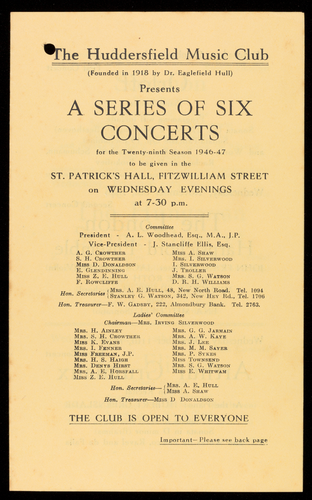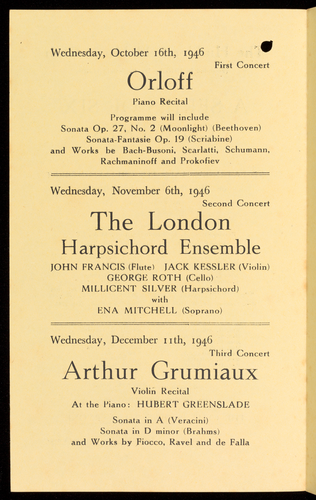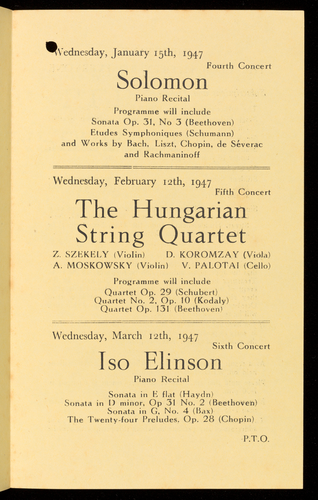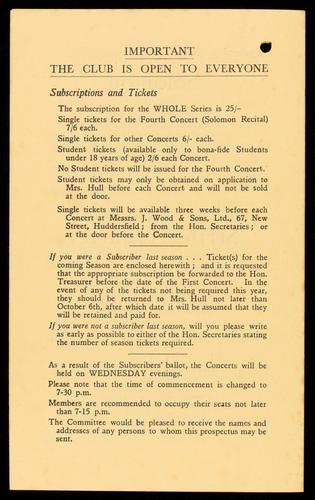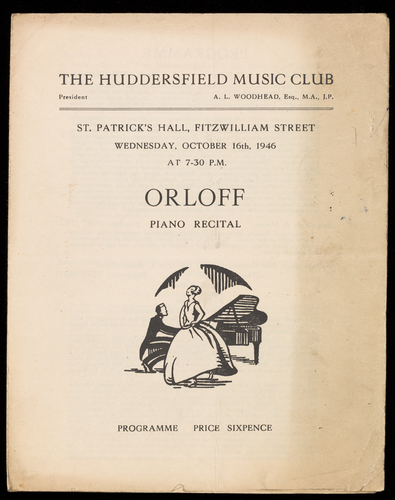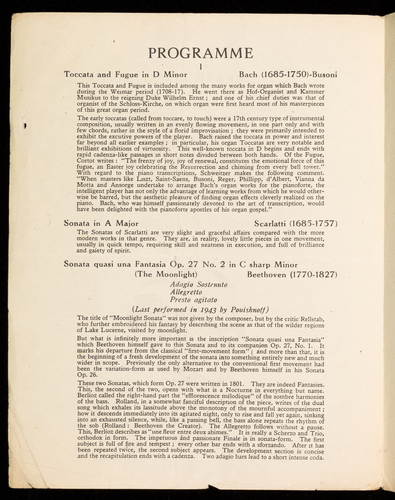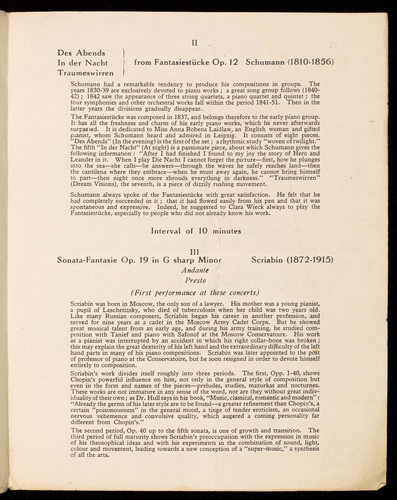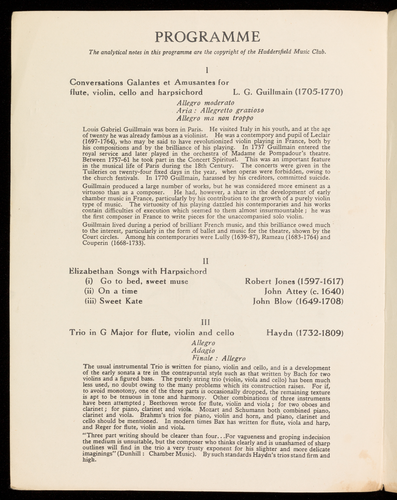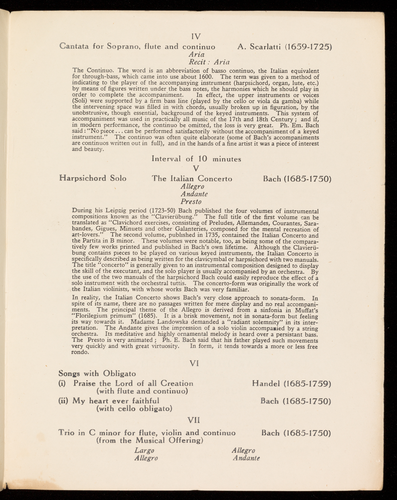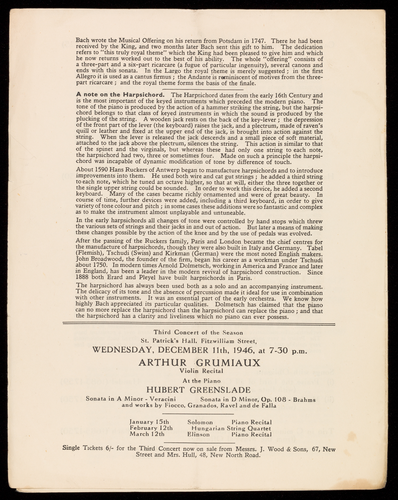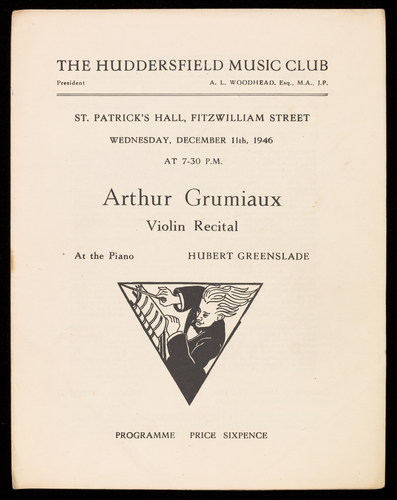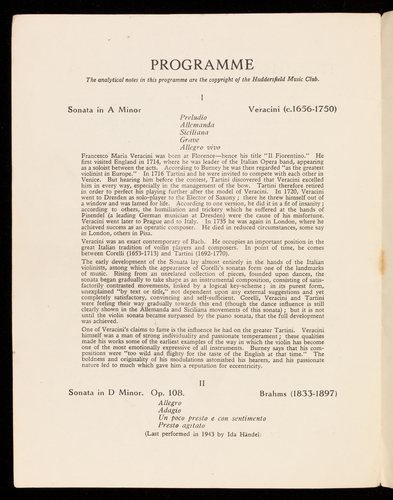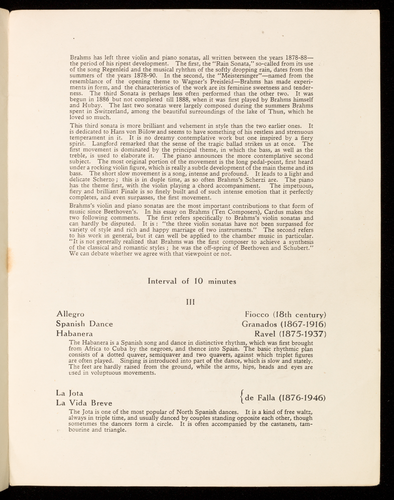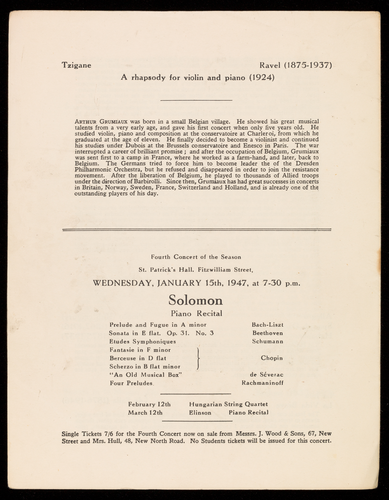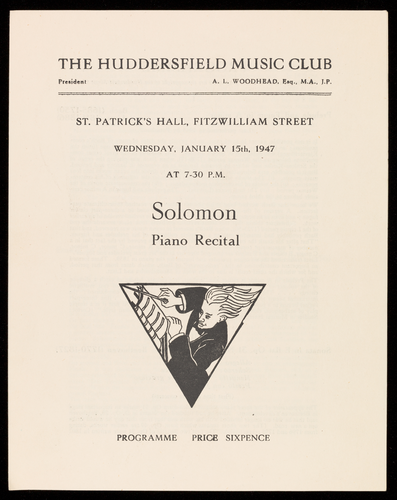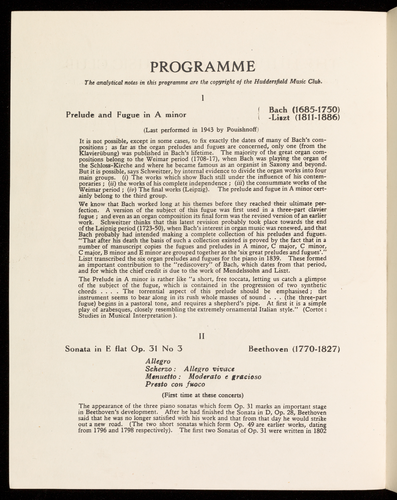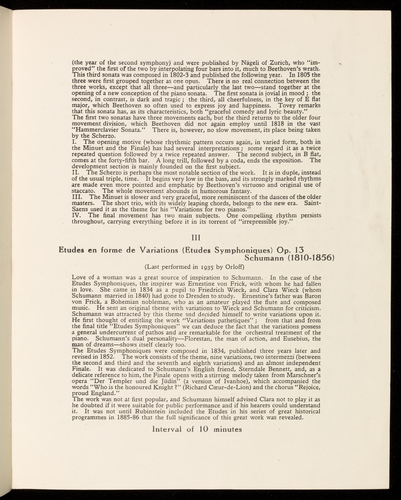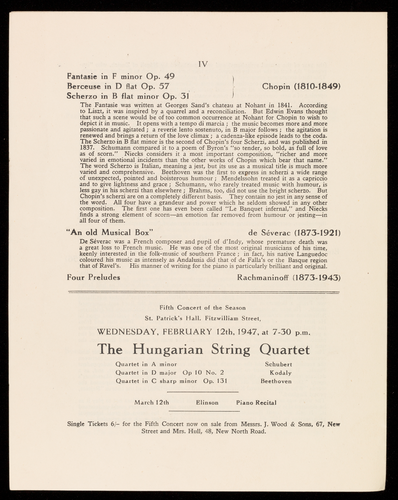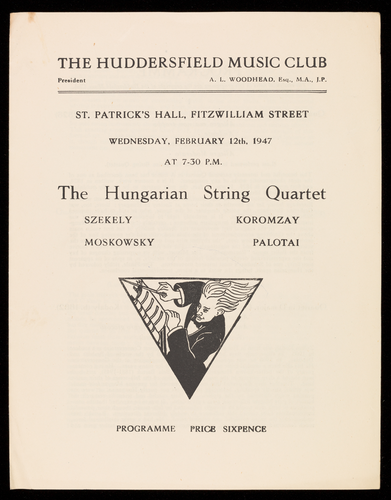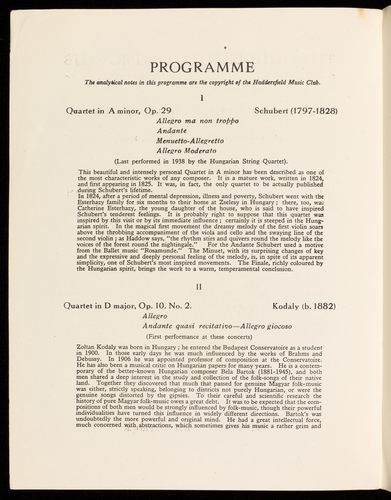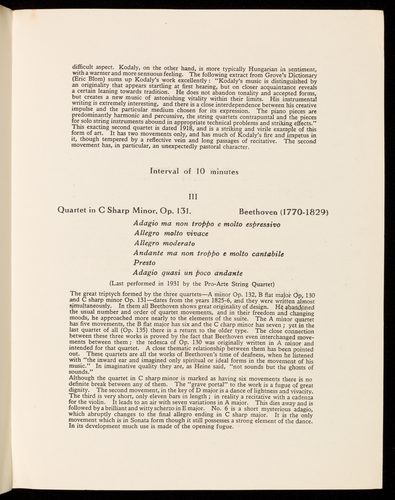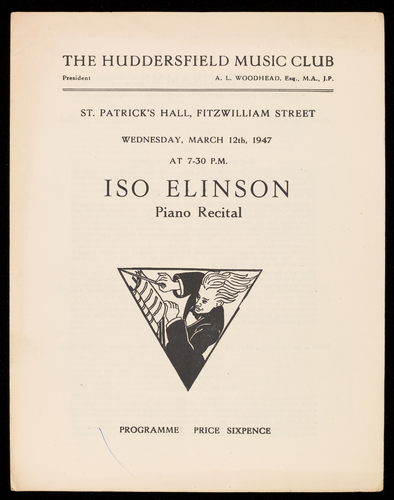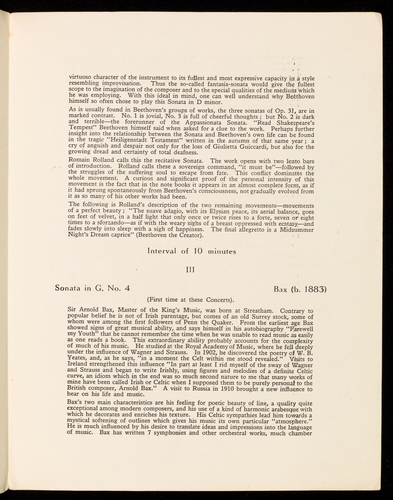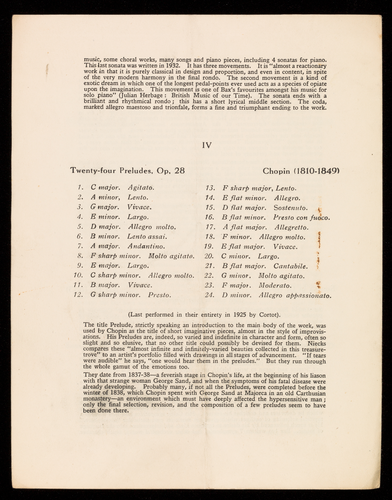Ocr'd Text:
The Huddersfield Music Club
(Founded in 1918 by Dr. Eaglefield Hull)
Presents
A SERIES OF SIX
CONCERTS
for the Twenty-ninth Season 1946-47
to be given in the
ST. PATRICK'S HALL, FITZWILLIAM STREET
on WEDNESDAY EVENINGS
at 7-30 p.m.
Committee
President A. L. Woodhead, Esq., M.A., J.P.
P
Vice-President
A. G. CROWTHER
S. H. CROWTHER
MISS D. DONALDSON
E. GLENDINNING
MISS Z. E. HULL
F. ROWCLIFFE
MRS. A. E. HULL, 48, New North Road. Tel. 1094
Hon. Secretaries { STANLEY G. WATSON, 342, New HEY Rd., Tel. 1706
Hon. Treasurer-F. W. GADSBY, 222, Almondbury Bank. Tel. 2763.
Ladies' Committee
Chairman-MRS.
MRS. H. AINLEY
MRS. S. H. CROWTHER
J. Stancliffe Ellis, Esq.
MISS A. SHAW
MRS. I. SILVERWOOD
I. SILVERWOOD
J. TROLLER
MRS. S. G. WATSON
D. R. H. WILLIAMS
MISS K. EVANS
MRS. I. FENNER
MISS FREEMAN, J.P.
MRS. H. S. HAIGH
MRS. DENYS HIRST
MRS. A. E, HORSFALL
MISS Z. E. HULL
"
IRVING SILVERWOOD
MRS. G. G. JARMAIN
MRS. A. W. KAYE
MRS. J. LEE
MRS. M. M. SAYER
MRS. P. SYKES
MISS TOWNSEND
MRS. S. G. WATSON
Miss E. WHITWAM
Hon. Secretaries-- MISS A. SHAW
MRS. A. E. HULL
{
Hon. Treasurer-Miss D DONALDSON
THE CLUB IS OPEN TO EVERYONE
Important- Please see back page
WALT D
Ocr'd Text:
Wednesday, October 16th, 1946
Orloff
Piano Recital
Programme will include
Sonata Op. 27, No. 2 (Moonlight) (Beethoven)
Sonata-Fantasie Op. 19 (Scriabine)
and Works be Bach-Busoni, Scarlatti, Schumann,
Rachmaninoff and Prokofiev
Wednesday, November 6th, 1946
First Concert
Second Concert
The London
Harpsichord Ensemble
JOHN FRANCIS (Flute) JACK KESSLER (Violin)
GEORGE ROTH (Cello)
MILLICENT SILVER (Harpsichord)
with
ENA MITCHELL (Soprano)
Violin Recital
Wednesday, December 11th, 1946
Third Concert
Arthur Grumiaux
At the Piano: HUBERT GREENSLADE
Sonata in A (Veracini)
Sonata in D minor (Brahms)
and Works by Fiocco, Ravel and de Falla
Ocr'd Text:
Wednesday, January 15th, 1947
Solomon
Piano Recital
Programme will include.
Sonata Op. 31, No 3 (Beethoven)
Etudes Symphoniques (Schumann)
and Works by Bach, Liszt, Chopin, de Séverac
and Rachmaninoff
Fourth Concert
Wednesday, February 12th, 1947
Fifth Concert
The Hungarian
String Quartet
Z. SZEKELY (Violin) D. KOROMZAY (Viola)
A. MOSKOWSKY (Violin) V. PALOTAI (Cello)
Wednesday, March 12th, 1947
Programme will include
Quartet Op. 29 (Schubert)
Quartet No. 2, Op. 10 (Kodaly)
Quartet Op. 131 (Beethoven)
Sixth Concert
Iso Elinson
Piano Recital
Sonata in E flat (Haydn)
Sonata in D minor, Op 31 No. 2 (Beethoven)
Sonata in G, No. 4 (Bax)
The Twenty-four Preludes, Op. 28 (Chopin)
P.T.O.
Ocr'd Text:
IMPORTANT
THE CLUB IS OPEN TO EVERYONE
Subscriptions and Tickets
The subscription for the WHOLE Series is 25/-
Single tickets for the Fourth Concert (Solomon Recital)
7/6 each.
Single tickets for other Concerts 6/- each.
Student tickets (available only to bona-fide Students
under 18 years of age) 2/6 each Concert.
No Student tickets will be issued for the Fourth Concert.
Student tickets may only be obtained on application to
Mrs. Hull before each Concert and will not be sold
at the door.
Single tickets will be available three weeks before each
Concert at Messrs. J. Wood & Sons, Ltd., 67, New
Street, Huddersfield; from the Hon. Secretaries; or
at the door before the Concert.
If you were a Subscriber last season... Ticket(s) for the
coming Season are enclosed here with; and it is requested
that the appropriate subscription be forwarded to the Hon.
Treasurer before the date of the First Concert. In the
event of any of the tickets not being required this year,
they should be returned to Mrs. Hull not later than
October 6th, after which date it will be assumed that they
will be retained and paid for.
If you were not a subscriber last season, will you please write
as early as possible to either of the Hon. Secretaries stating
the number of season tickets required.
As a result of the Subscribers' ballot, the Concerts will be
held on WEDNESDAY evenings.
Please note that the time of commencement is changed to
7-30 p.m.
Members are recommended to occupy their seats not later
than 7-15 p.m.
The Committee would be pleased to receive the names and
addresses of any persons to whom this prospectus may be
sent.
Ocr'd Text:
THE HUDDERSFIELD MUSIC CLUB
A. L. WOODHEAD, Esq., M.A., J, P.
President
ST. PATRICK'S HALL, FITZWILLIAM STREET
WEDNESDAY, OCTOBER 16th, 1946
AT 7-30 P.M.
ORLOFF
PIANO RECITAL
PROGRAMME PRICE SIXPENCE
Ocr'd Text:
PROGRAMME
1
Toccata and Fugue in D Minor
Bach (1685-1750)-Busoni
This Toccata and Fugue is included among the many works for organ which Bach wrote
during the Weimar period (1708-17). He went there as Hof-Organist and Kammer
Musikus to the reigning Duke Wilhelm Ernst; and one of his chief duties was that of
organist of the Schloss-Kirche, on which organ were first heard most of his masterpieces
of this great organ period.
The early toccatas (called from toccare, to touch) were a 17th century type of instrumental
composition, usually written in an evenly flowing movement, in one part only and with
few chords, rather in the style of a florid improvisation; they were primarily intended to
exhibit the excutive powers of the player. Bach raised the toccata in power and interest
far beyond all earlier examples; in particular, his organ Toccatas are very notable and
brilliant exhibitions of virtuosity. This well-known toccata in D begins and ends with
rapid cadenza-like passages in short notes divided between both hands. Of the Fugue,
Cortot writes: "The frenzy of joy, joy of renewal, constitutes the emotional force of this
fugue, an Easter joy celebrating the Resurrection and chiming from every bell tower."
With regard to the piano transcriptions, Schweitzer makes the following comment.
"When masters like Liszt, Saint-Saens, Busoni, Reger, Phillipp, d'Albert, Vianna da
Motta and Ansorge undertake to arrange Bach's organ works for the pianoforte, the
intelligent player has not only the advantage of learning works from which he would other-
wise be barred, but the aesthetic pleasure of finding organ effects cleverly realized on the
piano. Bach, who was himself passionately devoted to the art of transcription, would
have been delighted with the pianoforte apostles of his organ gospel."
Sonata in A Major
Scarlatti (1685-1757)
The Sonatas of Scarlatti are very slight and graceful affairs compared with the more
modern works in that genre. They are, in reality, lovely little pieces in one movement,
usually in quick tempo, requiring skill and neatness in execution, and full of brilliance
and gaiety of spirit.
Sonata quasi una Fantasia Op. 27 No. 2 in C sharp Minor
(The Moonlight)
Beethoven (1770-1827)
Adagio Sostenuto
Allegretto
Presto agitato
(Last performed in 1943 by Pouishnoff)
The title of "Moonlight Sonata" was not given by the composer, but by the critic Rellstab,
who further embroidered his fantasy by describing the scene as that of the wilder regions
of Lake Lucerne, visited by moonlight.
But what is infinitely more important is the inscription "Sonata quasi una Fantasia"
which Beethoven himself gave to this Sonata and to its companion Op. 27, No. 1. It
marks his departure from the classical "first-movement form"; and more than that, it is
the beginning of a fresh development of the sonata into something entirely new and much
wider in scope. Previously the only alternative to the conventional first movement had
been the variation-form as used by Mozart and by Beethoven himself in his Sonata
Op. 26.
These two Sonatas, which form Op. 27 were written in 1801. They are indeed Fantasies.
This, the second of the two, opens with what is a Nocturne in everything but name.
Berlioz called the right-hand part the "efflorescence mélodique" of the sombre harmonies
of the bass. Rolland, in a somewhat fanciful description of the piece, writes of the dual
song which exhales its lassitude above the monotony of the mournful accompaniment;
how it descends immediately into its agitated night, only to rise and fall yet again, sinking
into an exhausted silence, while, like a passing bell, the bass alone repeats the rhythm of
the sob (Rolland: Beethoven the Creator). The Allegretto follows without a pause.
This, Berlioz describes as "une fleur entre deux abimes." It is really a Scherzo and Trio,
orthodox in form. The impetuous and passionate Finale is in sonata-form. The first
subject is full of fire and tempest; every other bar ends with a sforzando. After it has
been repeated twice, the second subject appears. The development section is concise
and the recapitulation ends with a cadenza. Two adagio bars lead to a short intense coda.
Ocr'd Text:
II
Des Abends
In der Nacht
Traumeswirren
Schumann had a remarkable tendency to produce his compositions in groups. The
years 1830-39 are exclusively devoted to piano works; a great song group follows (1840-
42); 1842 saw the appearance of three string quartets, a piano quartet and quintet; the
four symphonies and other orchestral works fall within the period 1841-51. Then in the
latter years the divisions gradually disappear.
from Fantasiestücke Op. 12 Schumann (1810-1856)
The Fantasiestücke was composed in 1837, and belongs therefore to the early piano group.
It has all the freshness and charm of his early piano works, which he never afterwards
surpassed. It is dedicated to Miss Anna Robena Laidlaw, an English woman and gifted
pianist, whom Schumann heard and admired in Leipzig. It consists of eight pieces.
"Des Abends" (In the evening) is the first of the set; a rhythmic study "woven of twilight."
The fifth "In der Nacht" (At night) is a passionate piece, about which Schumann gives the
following information: "After I had finished I found to my joy the story of Hero and
Leander in it. When I play Die Nacht I cannot forget the picture-first, how he plunges
into the sea-she calls-he answers-through the waves he safely reaches land-then
the cantilena where they embrace-when he must away again, he cannot bring himself
to part-then night once more shrouds everything in darkness." "Traumeswirren"
(Dream Visions), the seventh, is a piece of dizzily rushing movement.
Schumann always spoke of the Fantasiestücke with great satisfaction. He felt that he
had completely succeeded in it; that it had flowed easily from his pen and that it was
spontaneous and expressive. Indeed, he suggested to Clara Wieck always to play the
Fantasiestücke, especially to people who did not already know his work.
Interval of 10 minutes
III
Sonata-Fantasie Op. 19 in G sharp Minor
Andante
Presto
Scriabin (1872-1915)
(First performance at these concerts)
Scriabin was born in Moscow, the only son of a lawyer. His mother was a young pianist,
a pupil of Leschetizsky, who died of tuberculosis when her child was two years old.
Like many Russian composers, Scriabin began his career in another profession, and
served for nine years as a cadet in the Moscow Army Cadet Corps. But he showed
great musical talent from an early age, and during his army training, he studied com-
position with Tanief and piano with Safonof at the Moscow Conservatoire. His work
as a pianist was interrupted by an accident in which his right collar-bone was broken;
this may explain the great dexterity of his left hand and the extraordinary difficulty of the left
hand parts in many of his piano compositions. Scriabin was later appointed to the post
of professor of piano at the Conservatoire, but he soon resigned in order to devote himself
entirely to composition.
Scriabin's work divides itself roughly into three periods. The first, Opp. 1-40, shows
Chopin's powerful influence on him, not only in the general style of composition but
even in the form and names of the pieces-preludes, studies, mazurkas and nocturnes.
These works are not immature in any sense of the word, nor are they without great indiv-
iduality of their own; as Dr. Hull says in his book, "Music, classical, romantic and modern":
"Already the germs of his later style are to be found-a greater refinement than Chopin's, a
certain "poisonousness" in the general mood, a tinge of tender eroticism, an occasional
nervous vehemence and convulsive quality, which augered a coming personality far
different from Chopin's."
The second period, Op. 40 up to the fifth sonata, is one of growth and transition. The
third period of full maturity shows Scriabin's preoccupation with the expression in music
of his theosophical ideas and with his experiments in the combination of sound, light,
colour and movement, leading towards a new conception of a "super-music," a synthesis
of all the arts.
Ocr'd Text:
Scriabin was essentially a composer for the piano. He had an original sense of it, which
has never been exceeded, even by Chopin. He wrote five major orchestral works, but
the bulk of his writing was for the piano. Ten piano sonatas were written at widely
different dates.
The Sonata-Fantasie is the second. It is in two movements only; the first was begun
in 1892 in Genoa, and the second written in 1897 in the Crimea. It is a much more
individual and powerful work than its predecessor. There is no real thematic relationship
between the movements, though the key-scheme connects them and a triplet rhythm
runs constantly through both. The first movement is in a modified sonata-form; the
repeated triplet figure is reminiscent of the "knocking of fate" in Beethoven's fifth sym-
phony. The final movement has three subjects-two in graceful filigree work and a
third melody of great nobility and beauty.
Prelude in G Minor
Toccata Op. 11
Rachmaninoff (1873-1943)
Prokofiev (b. 1891)
The Huddersfield Music Club
Second Concert of the Season
St. Patrick's Hall, Fitzwilliam Street,
WEDNESDAY, NOVEMBER 6th, 1946
at 7-30 p.m.
The London Harpsichord
Ensemble
(Flute, Violin, Cello and Harpsichord)
with Ena Mitchell (Soprano)
December 11th Grumiaux
Violin Recital
January 15th
Solomon
Piano Recital
February 12th
Hungarian String Quartet
Elinson
March 12th
Piano Recital
Single tickets 6/- for the Second Concert now on sale from Messrs. J.
Wood & Sons, 67, New Street and Mrs. Hull, 48, New North Road.
Ocr'd Text:
THE HUDDERSFIELD MUSIC CLUB
A. L. WOODHEAD, Esq., M.A., J.P.
President
ST. PATRICK'S HALL, FITZWILLIAM STREET
WEDNESDAY, NOVEMBER 6th, 1946
AT 7-30 P.M.
The London Harpsichord Ensemble
John Francis (Flute)
Jack Kessler (Violin)
George Roth (Cello)
Millicent Silver (Harpsichord)
with
ENA MITCHELL Soprano
||||
PROGRAMME PRICE SIXPENCE
Ocr'd Text:
PROGRAMME
The analytical notes in this programme are the copyright of the Huddersfield Music Club.
1
Conversations Galantes et Amusantes for
flute, violin, cello and harpsichord
Allegro moderato
Aria: Allegretto grazioso
Allegro ma non troppo
L. G. Guillmain (1705-1770)
Louis Gabriel Guillmain was born in Paris. He visited Italy in his youth, and at the age
of twenty he was already famous as a violinist. He was a contempory and pupil of Leclair
(1697-1764), who may be said to have revolutionized violin playing in France, both by
his compositions and by the brilliance of his playing. In 1737 Guillmain entered the
royal service and later played in the orchestra of Madame de Pompadour's theatre.
Between 1757-61 he took part in the Concert Spirituel. This was an important feature
in the musical life of Paris during the 18th Century. The concerts were given in the
Tuileries on twenty-four fixed days in the year, when operas were forbidden, owing to
the church festivals. In 1770 Guillmain, harassed by his creditors, committed suicide.
Guillmain produced a large number of works, but he was considered more eminent as a
virtuoso than as a composer. He had, however, a share in the development of early
chamber music in France, particularly by his contribution to the growth of a purely violin
type of music. The virtuosity of his playing dazzled his contemporaries and his works
contain difficulties of execution which seemed to them almost insurmountable; he was
the first composer in France to write pieces for the unaccompanied solo violin.
Guillmain lived during a period of brilliant French music, and this brilliance owed much
to the interest, particularly in the form of ballet and music for the theatre, shown by the
Court circles. Among his contemporaries were Lully (1639-87), Rameau (1683-1764) and
Couperin (1668-1733).
II
Elizabethan Songs with Harpsichord
(i) Go to bed, sweet muse
(ii) On a time
(iii) Sweet Kate
Robert Jones (1597-1617)
John Attey (c. 1640)
John Blow (1649-1708)
III
Trio in G Major for flute, violin and cello
Allegro
Adagio
Finale: Allegro
Haydn (1732-1809)
The usual instrumental Trio is written for piano, violin and cello, and is a development
of the early sonata a tre in the contrapuntal style such as that written by Bach for two
violins and a figured bass. The purely string trio (violin, viola and cello) has been much
less used, no doubt owing to the many problems which its construction raises. For if,
to avoid monotony, one of the three parts is occasionally dropped, the remaining texture
is apt to be tenuous in tone and harmony. Other combinations of three instruments
have been attempted; Beethoven wrote for flute, violin and viola; for two oboes and
clarinet; for piano, clarinet and viola. Mozart and Schumann both combined piano,
clarinet and viola. Brahms's trios for piano, violin and horn, and piano, clarinet and
cello should be mentioned. In modern times Bax has written for flute, viola and harp,
and Reger for flute, violin and viola.
"Three part writing should be clearer than four...For vagueness and groping indecision
the medium is unsuitable, but the composer who thinks clearly and is unashamed of sharp
outlines will find in the trio a very trusty exponent for his slighter and more delicate
imaginings" (Dunhill: Chamber Music). By such standards Haydn's trios stand firm and
high.
Ocr'd Text:
IV
Cantata for Soprano, flute and continuo
Aria
Recit: Aria
The Continuo. The word is an abbreviation of basso continuo, the Italian equivalent
for through-bass, which came into use about 1600. The term was given to a method of
indicating to the player of the accompanying instrument (harpsichord, organ, lute, etc.)
by means of figures written under the bass notes, the harmonies which he should play in
order to complete the accompaniment. In effect, the upper instruments or voices
(Soli) were supported by a firm bass line (played by the cello or viola da gamba) while
the intervening space was filled in with chords, usually broken up in figuration, by the
unobstrusive, though essential, background of the keyed instruments. This system of
accompaniment was used in practically all music of the 17th and 18th Century; and if,
in modern performance, the continuo be omitted, the loss is very great. Ph. Em. Bach
said: "No piece... can be performed satisfactorily without the accompaniment of a keyed
instrument." The continuo was often quite elaborate (some of Bach's accompaniments
are continuos written out in full), and in the hands of a fine artist it was a piece of interest
and beauty.
Harpsichord Solo
Interval of 10 minutes
V
The Italian Concerto
Allegro
Andante
Presto
During his Leipzig period (1723-50) Bach published the four volumes of instrumental
compositions known as the "Clavierübung. The full title of the first volume can be
translated as "Clavichord exercises, consisting of Preludes, Allemandes, Courantes, Sara-
bandes, Gigues, Minuets and other Galanteries, composed for the mental recreation of
art-lovers. The second volume, published in 1735, contained the Italian Concerto and
the Partita in B minor. These volumes were notable, too, as being some of the compara-
tively few works printed and published in Bach's own lifetime. Although the Clavierü-
bung contains pieces to be played on various keyed instruments, the Italian Concerto is
specifically described as being written for the clavicymbal or harpsichord with two manuals.
The title "concerto" is generally given to an instrumental composition designed to display
the skill of the executant, and the solo player is usually accompanied by an orchestra. By
the use of the two manuals of the harpsichord Bach could easily reproduce the effect of a
solo instrument with the orchestral tuttis. The concerto-form was originally the work of
the Italian violinists, with whose works Bach was very familiar.
Songs with Obligato
(i) Praise the Lord of all Creation
(with flute and continuo)
A. Scarlatti (1659-1725)
ments.
In reality, the Italian Concerto shows Bach's very close approach to sonata-form. In
spite of its name, there are no passages written for mere display and no real accompani-
The principal theme of the Allegro is derived from a sinfonia in Muffat's
"Florilegium primum" (1685). It is a brisk movement, not in sonata-form but feeling
its way towards it. Madame Landowska demanded a "radiant solemnity" in its inter-
pretation. The Andante gives the impression of a solo violin accompanied by a string
orchestra. Its meditative and highly ornamental melody is heard over a persistant bass.
The Presto is very animated; Ph. E. Bach said that his father played such movements
very quickly and with great virtuosity. In form, it tends towards a more or less free
rondo.
VI
(ii) My heart ever faithful
(with cello obligato)
VII
Trio in C minor for flute, violin and continuo
(from the Musical Offering)
Largo
Allegro
Bach (1685-1750)
Handel (1685-1759)
Bach (1685-1750)
Allegro
Andante
Bach (1685-1750)
Ocr'd Text:
Bach wrote the Musical Offering on his return from Potsdam in 1747. There he had been
received by the King, and two months later Bach sent this gift to him. The dedication
refers to "this truly royal theme" which the King had been pleased to give him and which
he now returns worked out to the best of his ability. The whole "offering" consists of
a three-part and a six-part ricarcare (a fugue of particular ingenuity), several canons and
ends with this sonata. In the Largo the royal theme is merely suggested; in the first
Allegro it is used as a cantus firmus; the Andante is reminiscent of motives from the three-
part ricarcare; and the royal theme forms the basis of the finale.
A note on the Harpsichord. The Harpsichord dates from the early 16th Century and
is the most important of the keyed instruments which preceded the modern piano. The
tone of the piano is produced by the action of a hammer striking the string, but the harpsi-
chord belongs to that class of keyed instruments in which the sound is produced by the
plucking of the string. A wooden jack rests on the back of the key-lever; the depression
of the front part of the lever (the keyboard) raises the jack, and a plectrum, made of raven's
quill or leather and fixed at the upper end of the jack, is brought into action against the
string. When the lever is released the jack descends and a small piece of soft material,
attached to the jack above the plectrum, silences the string. This action is similar to that
of the spinet and the virginals, but whereas these had only one string to each note,
the harpsichord had two, three or sometimes four. Made on such a principle the harpsi-
chord was incapable of dynamic modification of tone by difference of touch.
About 1590 Hans Ruckers of Antwerp began to manufacture harpsichords and to introduce
improvements into them. He used both wire and cat gut strings; he added a third string
to each note, which he tuned an octave higher, so that at will, either the three together or
the single upper string could be sounded. In order to work this device, he added a second
keyboard. Many of the cases became richly ornamented and were of great beauty. In
course of time, further devices were added, including a third keyboard, in order to give
variety of tone colour and pitch; in some cases these additions were so fantastic and complex
as to make the instrument almost unplayable and untuneable.
In the early harpsichords all changes of tone were controlled by hand stops which threw
the various sets of strings and their jacks in and out of action. But later a means of making
these changes possible by the action of the knee and by the use of pedals was evolved.
After the passing of the Ruckers family, Paris and London became the chief centres for
the manufacture of harpsichords, though they were also built in Italy and Germany. Tabel
(Flemish), Tschudi (Swiss) and Kirkman (German) were the most noted English makers.
John Broadwood, the founder of the firm, began his career as a workman under Tschudi
about 1750. In modern times Arnold Dolmetsch, working in America and France and later
in England, has been a leader in the modern revival of harpsichord construction. Since
1888 both Erard and Pleyel have built harpsichords in Paris.
The harpsichord has always been used both as a solo and an accompanying instrument.
The delicacy of its tone and the absence of percussion made it ideal for use in combination
with other instruments. It was an essential part of the early orchestra. We know how
highly Bach appreciated its particular qualities. Dolmetsch has claimed that the piano
can no more replace the harpsichord than the harpsichord can replace the piano; and that
the harpsichord has a clarity and liveliness which no piano can ever possess.
Third Concert of the Season
St. Patrick's Hall. Fitzwilliam Street,
WEDNESDAY, DECEMBER 11th, 1946, at 7-30 p.m.
ARTHUR GRUMIAUX
Violin Recital
At the Piano
HUBERT
Sonata in A Minor - Veracini
and works by Fiocco,
January 15th
February 12th
March 12th
GREENSLADE
Sonata in D Minor, Op. 108 - Brahms
Granados, Ravel and de Falla
Solomon
Hungarian
Elinson
Piano Recital
String Quartet
Piano Recital
Single Tickets 6/- for the Third Concert now on sale from Messrs. J. Wood & Sons, 67, New
Street and Mrs. Hull, 48, New North Road.
Ocr'd Text:
THE HUDDERSFIELD MUSIC CLUB
A. L. WOODHEAD, Esq., M.A., J.P.
President
ST. PATRICK'S HALL, FITZWILLIAM STREET
WEDNESDAY, DECEMBER 11th, 1946
AT 7-30 P.M.
Arthur Grumiaux
Violin Recital
At the Piano
HUBERT GREENSLADE
PROGRAMME PRICE SIXPENCE
Ocr'd Text:
PROGRAMME
The analytical notes in this programme are the copyright of the Huddersfield Music Club.
1
Sonata in A Minor
Preludio
Allemanda
Siciliana
Grave
Allegro vivo
Francesco Maria Veracini was born at Florence-hence his title "Il Fiorentino." He
first visited England in 1714, where he was leader of the Italian Opera band, appearing
as a soloist between the acts. According to Burney he was then regarded "as the greatest
violinist in Europe." In 1716 Tartini and he were invited to compete with each other in
Venice. But hearing him before the contest, Tartini discovered that Veracini excelled
him in every way, especially in the management of the bow. Tartini therefore retired
in order to perfect his playing further after the model of Veracini. In 1720, Veracini
went to Dresden as solo-player to the Elector of Saxony; there he threw himself out of
a window and was lamed for life. According to one version, he did it in a fit of insanity;
according to others, the humiliation and trickery which he suffered at the hands of
Pisendel (a leading German musician at Dresden) were the cause of his misfortune.
Veracini went later to Prague and to Italy.
achieved success as an operatic composer.
in London, others in Pisa.
Veracini (c.1656-1750)
In 1735 he was again in London, where he
He died in reduced circumstances, some say
Veracini was an exact contemporary of Bach. He occupies an important position in the
great Italian tradition of voilin players and composers. In point of time, he comes
between Corelli (1653-1713) and Tartini (1692-1770).
The early development of the Sonata lay almost entirely in the hands of the Italian
violinists, among which the appearance of Corelli's sonatas form one of the landmarks
of music. Rising from an unrelated collection of pieces, founded upon dances, the
sonata began gradually to take shape as an instrumental composition, consisting of satis-
factorily contrasted movements, linked by a logical key-scheme; in its purest form,
unexplained "by text or title," not dependent upon any external suggestions and yet
completely satisfactory, convincing and self-sufficient. Corelli, Veracini and Tartini
were feeling their way gradually towards this end (though the dance influence is still
clearly shown in the Allemanda and Siciliana movements of this sonata); but it is not
until the violin sonata became surpassed by the piano sonata, that the full development
was achieved.
Sonata in D Minor. Op. 108.
Allegro
Adagio
One of Veracini's claims to fame is the influence he had on the greater Tartini. Veracini
himself was a man of strong individuality and passionate temperament; these qualities
made his works some of the earliest examples of the way in which the violin has become
one of the most emotionally expressive of all instruments. Burney says that his com-
positions were "too wild and flighty for the taste of the English at that time." The
boldness and originality of his modulations astonished his hearers, and his passionate
nature led to much which gave him a reputation for eccentricity.
II
Brahms (1833-1897)
Un poco presto e con sentimento
Presto agitato
(Last performed in 1943 by Ida Händel)
Ocr'd Text:
Brahms has left three violin and piano sonatas, all written between the years 1878-88-
the period of his ripest development. The first, the "Rain Sonata," so-called from its use
of the song Regenleid and the musical ryhthm of the softly dropping rain, dates from the
summers of the years 1878-90. In the second, the "Meistersinger"-named from the
resemblance of the opening theme to Wagner's Preisleid-Brahms has made experi-
ments in form, and the characteristics of the work are its feminine sweetness and tender-
The third Sonata is perhaps less often performed than the other two.
It was
begun in 1886 but not completed till 1888, when it was first played by Brahms himself
and Hubay. The last two sonatas were largely composed during the summers Brahms
spent in Switzerland, among the beautiful surroundings of the lake of Thun, which he
ness.
loved so much.
This third sonata is more brilliant and vehement in style than the two earlier ones. It
is dedicated to Hans von Bülow and seems to have something of his restless and strenuous
temperament in it. It is no dreamy contemplative work but one inspired by a fiery
spirit. Langford remarked that the sense of the tragic ballad strikes us at once. The
first movement is dominated by the principal theme, in which the bass, as well as the
treble, is used to elaborate it. The piano announces the more contemplative second
subject. The most original portion of the movement is the long pedal-point, first heard
under a rocking violin figure, which is really a subtle development of the main theme and its
bass. The short slow movement is a song, intense and profound. It leads to a light and
delicate Scherzo; this is in duple time, as so often Brahms's Scherzi are.
The piano
has the theme first, with the violin playing a chord accompaniment. The impetuous,
fiery and brilliant Finale is so finely built and of such intense emotion that it perfectly
completes, and even surpasses, the first movement.
Brahms's violin and piano sonatas are the most important contributions to that form of
music since Beethoven's. In his essay on Brahms (Ten Composers), Cardus makes the
two following comments. The first refers specifically to Brahms's violin sonatas and
can hardly be disputed. It is: "the three violin sonatas have not been surpassed for
variety of style and rich and happy marriage of two instruments." The second refers
to his work in general, but it can well be applied to the chamber music in particular.
"It is not generally realized that Brahms was the first composer to achieve a synthesis
of the classical and romantic styles; he was the off-spring of Beethoven and Schubert."
We can debate whether we agree with that viewpoint or not.
Interval of 10 minutes
La Jota
La Vida Breve
III
Allegro
Spanish Dance
Fiocco (18th century)
Granados (1867-1916)
Ravel (1875-1937)
Habanera
The Habanera is a Spanish song and dance in distinctive rhythm, which was first brought
from Africa to Cuba by the negroes, and thence into Spain. The basic rhythmic plan
consists of a dotted quaver, semiquaver and two quavers, against which triplet figures
are often played. Singing is introduced into part of the dance, which is slow and stately.
The feet are hardly raised from the ground, while the arms, hips, heads and eyes are
used in voluptuous movements.
{de Falla (1876-1946)
The Jota is one of the most popular of North Spanish dances. It is a kind of free waltz,
always in triple time, and usually danced by couples standing opposite each other, though
sometimes the dancers form à circle. It is often accompanied by the castanets, tam-
bourine and triangle.
Ocr'd Text:
Tzigane
A rhapsody for violin and piano (1924)
ARTHUR GRUMIAUX was born in a small Belgian village. He showed his great musical
talents from a very early age, and gave his first concert when only five years old. He
studied violin, piano and composition at the conservatoire at Charleroi, from which he
graduated at the age of eleven. He finally decided to become a violinist and continued
his studies under Dubois at the Brussels conservatoire and Enesco in Paris. The war
interrupted a career of brilliant promise; and after the occupation of Belgium, Grumiaux
was sent first to a camp in France, where he worked as a farm-hand, and later, back to
Belgium. The Germans tried to force him to become leader the of the Dresden
Philharmonic Orchestra, but he refused and disappeared in order to join the resistance
After the liberation of Belgium, he played to thousands of Allied troops
under the direction of Barbirolli. Since then, Grumiaux has had great successes in concerts
in Britain, Norway, Sweden, France, Switzerland and Holland, and is already one of the
outstanding players of his day.
movement.
Fourth Concert of the Season
St. Patrick's Hall. Fitzwilliam Street,
WEDNESDAY, JANUARY 15th, 1947, at 7-30 p.m.
Solomon
Ravel (1875-1937)
Piano Recital
Prelude and Fugue in A minor
Sonata in E flat. Op. 31. No. 3
Etudes Symphoniques
Fantasie in F minor
Berceuse in D flat
Scherzo in B flat minor
"An Old Musical Box"
Four Preludes.
February 12th
March 12th
Bach-Liszt
Beethoven
Schumann
Chopin
de Séverac
Rachmaninoff
Hungarian String Quartet
Elinson
Piano Recital
Single Tickets 7/6 for the Fourth Concert now on sale from Messrs. J. Wood & Sons, 67, New
Street and Mrs. Hull, 48, New North Road. No Students tickets will be issued for this concert.
Ocr'd Text:
THE HUDDERSFIELD MUSIC CLUB
A. L. WOODHEAD, Esq., M.A., J.P.
President
ST. PATRICK'S HALL, FITZWILLIAM STREET
WEDNESDAY, JANUARY 15th, 1947
AT 7-30 P.M.
Solomon
Piano Recital
PROGRAMME PRICE SIXPENCE
Ocr'd Text:
PROGRAMME
The analytical notes in this programme are the copyright of the Huddersfield Music Club.
1
Prelude and Fugue in A minor
Bach (1685-1750)
-Liszt (1811-1886)
(Last performed in 1943 by Pouishnoff)
It is not possible, except in some cases, to fix exactly the dates of many of Bach's com-
positions; as far as the organ preludes and fugues are concerned, only one (from the
Klavierübung) was published in Bach's lifetime. The majority of the great organ com-
positions belong to the Weimar period (1708-17), when Bach was playing the organ of
the Schloss-Kirche and where he became famous as an organist in Saxony and beyond.
But it is possible, says Schweitzer, by internal evidence to divide the organ works into four
main groups. (i) The works which show Bach still under the influence of his contem-
poraries; (ii) the works of his complete independence; (iii) the consummate works of the
Weimar period; (iv) The final works (Leipzig). The prelude and fugue in A minor cert-
ainly belong to the third group.
We know that Bach worked long at his themes before they reached their ultimate per-
fection. A version of the subject of this fugue was first used in a three-part clavier
fugue; and even as an organ composition its final form was the revised version of an earlier
work. Schweitzer thinks that this latest revision probably took place towards the end
of the Leipzig period (1723-50), when Bach's interest in organ music was renewed, and that
Bach probably had intended making a complete collection of his preludes and fugues.
"That after his death the basis of such a collection existed is proved by the fact that in a
number of manuscript copies the fugues and preludes in A minor, C major, C minor,
C major, B minor and E minor are grouped together as the 'six great preludes and fugues'.'
Liszt transcribed the six organ preludes and fugues for the piano in 1839. These formed
an important contribution to the "rediscovery" of Bach, which dates from that period,
and for which the chief credit is due to the work of Mendelssohn and Liszt.
The Prelude in A minor is rather like "a short, free toccata, letting us catch a glimpse
of the subject of the fugue, which is contained in the progression of two synthetic
chords . . . . The torrential aspect of this prelude should be emphasised; the
instrument seems to bear along in its rush whole masses of sound... (the three-part
fugue) begins in a pastoral tone, and requires a shepherd's pipe. At first it is a simple
play of arabesques, closely resembling the extremely ornamental Italian style." (Cortot:
Studies in Musical Interpretation).
II
Beethoven (1770-1827)
Sonata in E flat Op. 31 No 3
Allegro
Scherzo: Allegro vivace
Menuetto: Moderato e gracioso
Presto con fuoco
(First time at these concerts)
The appearance of the three piano sonatas which form Op. 31 marks an important stage
in Beethoven's development. After he had finished the Sonata in D, Op. 28, Beethoven
said that he was no longer satisfied with his work and that from that day he would strike
out a new road. (The two short sonatas which form Op. 49 are earlier works, dating
from 1796 and 1798 respectively). The first two Sonatas of Op. 31 were written in 1802
Ocr'd Text:
(the year of the second symphony) and were published by Nägeli of Zurich, who "im-
proved" the first of the two by interpolating four bars into it, much to Beethoven's wrath.
This third sonata was composed in 1802-3 and published the following year.
In 1805 the
three were first grouped together as one opus. There is no real connection between the
three works, except that all three-and particularly the last two-stand together at the
opening of a new conception of the piano sonata. The first sonata is jovial in mood; the
second, in contrast, is dark and tragic; the third, all cheerfulness, in the key of E flat
major, which Beethoven so often used to express joy and happiness. Tovey remarks
that this sonata has, as its characteristics, both "graceful comedy and lyric beauty.
The first two sonatas have three movements each, but the third returns to the older four
movement division, which Beethoven did not again employ until 1818 in the vast
"Hammerclavier Sonata." There is, however, no slow movement, its place being taken
by the Scherzo.
I. The opening motive (whose rhythmic pattern occurs again, in varied form, both in
the Minuet and the Finale) has had several interpretations; some regard it as a twice
repeated question followed by a twice repeated answer. The second subject, in B flat,
comes at the forty-fifth bar. A long trill, followed by a coda, ends the exposition. The
development section is mainly founded on the first subject.
II. The Scherzo is perhaps the most notable section of the work. It is in duple, instead
of the usual triple, time. It begins very low in the bass, and its strongly marked rhythms
are made even more pointed and emphatic by Beethoven's virtuoso and original use of
The whole movement abounds in humorous fantasy.
staccato.
III. The Minuet is slower and very graceful, more reminiscent of the dances of the older
masters. The short trio, with its widely leaping chords, belongs to the new era. Saint-
Saens used it as the theme for his "Variations for two pianos.'
IV. The final movement has two main subjects. One compelling rhythm persists
throughout, carrying everything before it in its torrent of "irrepressible joy."
III
Etudes en forme de Variations (Etudes Symphoniques) Op. 13
Schumann (1810-1856)
(Last performed in 1935 by Orloff)
Love of a woman was a great source of inspiration to Schumann. In the case of the
Etudes Symphoniques, the inspirer was Ernestine von Frick, with whom he had fallen
in love. She came in 1834 as a pupil to Friedrich Wieck, and Clara Wieck (whom
Schumann married in 1840) had gone to Dresden to study. Ernestine's father was Baron
von Frick, a Bohemian nobleman, who as an amateur played the flute and composed
music. He sent an original theme with variations to Wieck and Schumann for criticism.
Schumann was attracted by this theme and decided himself to write variations upon it.
He first thought of entitling the work "Variations pathetiques" ; from that and from
the final title "Etudes Symphoniques" we can deduce the fact that the variations possess
a general undercurrent of pathos and are remarkable for the orchestral treatment of the
piano. Schumann's dual personality-Florestan, the man of action, and Eusebius, the
man of dreams-shows itself clearly too.
The Etudes Symphoniques were composed in 1834, published three years later and
revised in 1852. The work consists of the theme, nine variations, two intermezzi (between
the second and third and the seventh and eighth variations) and an almost independent
Finale. It was dedicated to Schumann's English friend, Sterndale Bennett, and, as a
delicate reference to him, the Finale opens with a stirring melody taken from Marschner's
opera "Der Templer und die Jüdin" (a version of Ivanhoe), which accompanied the
words "Who is the honoured Knight?" (Richard Cœur-de-Lion) and the chorus "Rejoice,
proud England."
The work was not at first popular, and Schumann himself advised Clara not to play it as
he doubted if it were suitable for public performance and if his hearers could understand
it. It was not until Rubinstein included the Etudes in his series of great historical
programmes in 1885-86 that the full significance of this great work was revealed.
Interval of 10 minutes
Ocr'd Text:
IV
Fantasie in F minor Op. 49
Berceuse in D flat Op. 57
Chopin (1810-1849)
Scherzo in B flat minor Op. 31
The Fantasie was written at Georges Sand's chateau at Nohant in 1841. According
to Liszt, it was inspired by a quarrel and a reconciliation. But Edwin Evans thought
that such a scene would be of too common occurrence at Nohant for Chopin to wish to
depict it in music. It opens with a tempo di marcia; the music becomes more and more
passionate and agitated; a reverie lento sostenuto, in B major follows; the agitation is
renewed and brings a return of the love climax; a cadenza-like episode leads to the coda.
The Scherzo in B flat minor is the second of Chopin's four Scherzi, and was published in
1837. Schumann compared it to a poem of Byron's "so tender, so bold, as full of love
as of scorn.” Niecks considers it a most important composition, "richer and more
varied in emotional incidents than the other works of Chopin which bear that name."
The word Scherzo is Italian, meaning a jest, but its use as a musical title is much more
varied and comprehensive. Beethoven was the first to express in scherzi a wide range
of unexpected, pointed and boisterous humour; Mendelssohn treated it as a capriccio
and to give lightness and grace; Schumann, who rarely treated music with humour, is
less gay in his scherzi than elsewhere; Brahms, too, did not use the bright scherzo.
Chopin's scherzi are on a completely different basis. They contain no jest in any sense of
the word. All four have a grandeur and power which he seldom showed in any other
composition. The first one has even been called "Le Banquet infernal," and Niecks
finds a strong element of scorn-an emotion far removed from humour or jesting-in
all four of them.
But
"An old Musical Box"
de Séverac (1873-1921)
De Séverac was a French composer and pupil of d'Indy, whose premature death was
a great loss to French music. He was one of the most original musicians of his time,
keenly interested in the folk-music of southern France; in fact, his native Languedoc
coloured his music as intensely as Andalusia did that of de Falla's or the Basque region
that of Ravel's. His manner of writing for the piano is particularly brilliant and original.
Four Preludes
Rachmaninoff (1873-1943)
Fifth Concert of the Season
St. Patrick's Hall. Fitzwilliam Street,
WEDNESDAY, FEBRUARY 12th, 1947, at 7-30 p.m.
The Hungarian String Quartet
Quartet in A minor
Quartet in D major Op 10 No. 2
Quartet in C sharp minor Op. 131
March 12th
Elinson
Schubert
Kodaly
Beethoven
Piano Recital
Single Tickets 6/- for the Fifth Concert now on sale from Messrs. J. Wood & Sons, 67, New
Street and Mrs. Hull, 48, New North Road.
Ocr'd Text:
THE HUDDERSFIELD MUSIC CLUB
A. L. WOODHEAD, Esq., M.A., J.P.
President
ST. PATRICK'S HALL, FITZWILLIAM STREET
WEDNESDAY, FEBRUARY 12th, 1947
The Hungarian String Quartet
SZEKELY
AT 7-30 P.M.
MOSKOWSKY
100
za
KOROMZAY
PALOTAI
PROGRAMME PRICE SIXPENCE
Ocr'd Text:
PROGRAMME
The analytical notes in this programme are the copyright of the Huddersfield Music Club.
1
Quartet in A minor, Op. 29
Allegro ma non troppo
Andante
Schubert (1797-1828)
Menuetto-Allegretto
Allegro Moderato
(Last performed in 1938 by the Hungarian String Quartet).
This beautiful and intensely personal Quartet in A minor has been described as one of
the most characteristic works of any composer. It is a mature work, written in 1824,
and first appearing in 1825. It was, in fact, the only quartet to be actually published
during Schubert's lifetime.
In 1824, after a period of mental depression, illness and poverty, Schubert went with the
Esterhazy family for six months to their home at Zselesy in Hungary; there, too, was
Catherine Esterhazy, the young daughter of the house, who is said to have inspired
Schubert's tenderest feelings. It is probably right to suppose that this quartet was
inspired by this visit or by its immediate influence; certainly it is steeped in the Hung-
arian spirit. In the magical first movement the dreamy melody of the first violin soars
above the throbbing accompaniment of the viola and cello and the swaying line of the
second violin; as Haddow says, "the rhythm stirs and quivers round the melody like the
voices of the forest round the nightingale." For the Andante Schubert used a motive
from the Ballet music "Rosamunde." The Minuet, with its surprising changes of key
and the expressive and deeply personal feeling of the melody, is, in spite of its apparent
simplicity, one of Schubert's most inspired movements. The Finale, richly coloured by
the Hungarian spirit, brings the work to a warm, temperamental conclusion.
II
Quartet in D major, Op. 10. No. 2.
Allegro
Andante quasi recitativo-Allegro giocoso
(First performance at these concerts)
Zoltan Kodaly was born in Hungary; he entered the Budapest Conservatoire as a student
in 1900. In those early days he was much influenced by the works of Brahms and
Debussy. In 1906 he was appointed professor of composition at the Conservatoire.
He has also been a musical critic on Hungarian papers for many years. He is a contem-
porary of the better-known Hungarian composer Bela Bartok (1881-1945), and both
men shared a deep interest in the study and collection of the folk-songs of their native
land. Together they discovered that much that passed for genuine Magyar folk-music
was either, strictly speaking, belonging to districts not purely Hungarian, or were the
genuine songs distorted by the gipsies. To their careful and scientific research the
history of pure Magyar folk-music owes a great debt. It was to be expected that the com-
positions of both men would be strongly influenced by folk-music, though their powerful
individualities have turned this influence in widely different directions. Bartok's was
undoubtedly the more powerful and original mind. He had a great intellectual force,
much concerned with, abstractions, which sometimes gives his music a rather grim and
Kodaly (b. 1882)
Ocr'd Text:
difficult aspect. Kodaly, on the other hand, is more typically Hungarian in sentiment,
with a warmer and more sensuous feeling. The following extract from Grove's Dictionary
(Eric Blom) sums up Kodaly's work excellently: "Kodaly's music is distinguished by
an originality that appears startling at first hearing, but on closer acquaintance reveals
a certain leaning towards tradition. He does not abandon tonality and accepted forms,
but creates a new music of astonishing vitality within their limits. His instrumental
writing is extremely interesting, and there is a close interdependence between his creative
impulse and the particular medium chosen for its expression. The piano pieces are
predominantly harmonic and percussive, the string quartets contrapuntal and the pieces
for solo string instruments abound in appropriate technical problems and striking effects."
This exacting second quartet is dated 1918, and is a striking and virile example of this
form of art. It has two movements only, and has much of Kodaly's fire and impetus in
it, though tempered by a reflective vein and long passages of recitative. The second
movement has, in particular, an unexpectedly pastoral character.
Interval of 10 minutes
III
Quartet in C Sharp Minor, Op. 131.
Beethoven (1770-1829)
Adagio ma non troppo e molto espressivo
Allegro molto vivace
Allegro moderato
Andante ma non troppo e molto cantabile
Presto
Adagio quasi un poco andante
(Last performed in 1931 by the Pro-Arte String Quartet)
The great triptych formed by the three quartets-A minor Op. 132, B flat major Op, 130
and C sharp minor Op. 131-dates from the years 1825-6, and they were written almost
simultaneously. In them all Beethoven shows great originality of design. He abandoned
the usual number and order of quartet movements, and in their freedom and changing
moods, he approached more nearly to the elements of the suite. The A minor quartet
has five movements, the B flat major has six and the C charp minor has seven; yet in the
last quartet of all (Op. 135) there is a return to the older type. The close connection
between these three works is proved by the fact that Beethoven even interchanged move-
ments between them; the tedesca of Op. 130 was originally written in A minor and
intended for that quartet. A close thematic relationship between them has been pointed
These quartets are all the works of Beethoven's time of deafness, when he listened
with "the inward ear and imagined only spiritual or ideal forms in the movement of his
music." In imaginative quality they are, as Heine said, "not sounds but the ghosts of
sounds."
out.
Although the quartet in C sharp minor is marked as having six movements there is no
definite break between any of them. The "grave portal" to the work is a fugue of great
dignity. The second movement, in the key of D major is a dance of lightness and vivacity.
The third is very short, only eleven bars in length; in reality a recitative with a cadenza
for the violin. It leads to an air with seven variations in A major. This dies away and is
followed by a brilliant and witty scherzo in E major. No. 6 is a short mysterious adagio,
which abruptly changes to the final allegro ending in C sharp major. It is the only
movement which is in Sonata form though it still possesses a strong element of the dance.
In its development much use is made of the opening fugue.
Ocr'd Text:
Sixth Concert of the Season
St. Patrick's Hall. Fitzwilliam Street,
WEDNESDAY, MARCH 12th, 1947, at 7-30 p.m.
Iso Elinson
Piano Recital
Sonata in E flat
Haydn
Sonata in D minor, Op. 31. No. 2 Beethoven
Sonata in G No. 4
Twenty-four Preludes, Op. 28
Bax
Chopin
Single Tickets 6/- for the Sixth Concert now on sale from Messrs. J. Wood & Sons, 67, New
Street and Mrs. Hull, 48, New North Road.
Ocr'd Text:
THE HUDDERSFIELD MUSIC CLUB
A. L. WOODHEAD, Esq., M.A., J.P.
President
ST. PATRICK'S HALL, FITZWILLIAM STREET
WEDNESDAY, MARCH 12th, 1947
AT 7-30 P.M.
ISO ELINSON
Piano Recital
PROGRAMME PRICE SIXPENCE
Ocr'd Text:
PROGRAMME
The analytical notes in this programme are the copyright of the Huddersfield Music Club.
1
Sonata in E flat
Allegro
Adagio
Finale, Presto
Haydn (1732-1809
(Last performed in 1943 by Eileen Joyce).
Haydn wrote more than 50 sonatas for the piano. The long span of his life forms the
link between the early piano sonatas of C. P. E. Bach and Scarlatti and the mature works
of Beethoven. Many of Haydn's sonatas are slight, if charming works, but a few are of
importance, particularly this Sonata in E flat, the largest and most elaborate he ever wrote
and one which definitely leads towards the great sonatas of the future.
The first movement opens with imposing chords, which are soon repeated an octave higher;
this time ending with a long scale passage, from which grows the many melodic runs
throughout the movement. There is no second subject proper, but much use is made of
a new theme (bar 27), which Tovey describes as "the most hilarious tune in the world.
The development section is really based upon its many beautiful and, for the period,
daring modulations, which give an impression of spaciousness and mystery, quite astonish-
ing in a work of these proportions. Tovey remarks: "It is no exaggeration to say that
in this respect the present sonata is one of the most interesting compositions in all music."
The slow movement continues the unusual key-scheme, being in the remote key of E
major. The whole of the movement is derived from the first four bars, exquisitely
decorated with delicate ornamentation.
Tovey calls the opening of the final movement "a landmark in aesthetics. The adagio
prepared us for its solemnity by the initial shock of its first chord in so distant a key; the
finale brings us back to activity and laughter, by a pretence of explaining away that distant
key and all the solemn thoughts it brought." The tapped G natural of the opening, feels
like the minor third of the key of the slow movement, but the entry of the E flat in the bass
swings the key back abruptly to E flat major. The movement itself is in usual first-
movement form, the key scheme quite conventional and there is no coda. The most
striking section is that leading to a return of the first theme-"one of the most extrav-
agantly comical passages Haydn ever wrote" (Tovey).
II
Sonata in D minor, Op. 31, No. 2
Allegro
Adagio
Allegretto
Beethoven (1770-1827)
(First time at these Concerts)
This Sonata, together with its companion in G major, Op. 31, No. 1, was written in 1802
when Beethoven, at the height of his powers as composer and virtuoso, his life, as yet,
comparatively unclouded, was seeking for new means of self-expression and new worlds
to conquer. From now, Beethoven, with the exception of the E flat Sonata, Op. 31, No. 3
and the B flat major Sonata, Op. 106 (Hammerklavier), abandoned completely the
regular four-movement plan of the sonata. It seemed to him that the further develop-
ment of the piano sonata lay, not in formal construction, but in using the essentially
Ocr'd Text:
virtuoso character of the instrument to its fullest and most expressive capacity in a style
resembling improvisation. Thus the so-called fantasia-sonata would give the fullest
scope to the imagination of the composer and to the special qualities of the medium which
he was employing. With this ideal in mind, one can well understand why Beethoven
himself so often chose to play this Sonata in D minor.
As is usually found in Beethoven's groups of works, the three sonatas of Op. 31, are in
marked contrast. No. 1 is jovial, No. 3 is full of cheerful thoughts; but No. 2 is dark
and terrible-the forerunner of the Appassionata Sonata. "Read Shakespeare's
Tempest" Beethoven himself said when asked for a clue to the work. Perhaps further
insight into the relationship between the Sonata and Beethoven's own life can be found
in the tragic "Heiligenstadt Testament" written in the autumn of that same year; a
cry of anguish and despair not only for the loss of Giulietta Guiccardi, but also for the
growing dread and certainty of total deafness.
Romain Rolland calls this the recitative Sonata. The work opens with two lento bars
of introduction. Rolland calls these a sovereign command, "it must be"-followed by
the struggles of the suffering soul to escape from fate. This conflict dominates the
whole movement. A curious and significant proof of the personal intensity of this
movement is the fact that in the note books it appears in an almost complete form, as if
it had sprung spontaneously from Beethoven's consciousness, not gradually evolved from
it as so many of his other works had been.
The following is Rolland's description of the two remaining movements-movements
of a perfect beauty; "The suave adagio, with its Elysian peace, its aerial balance, goes
on feet of velvet, in a half light that only once or twice rises to a forte, seven or eight
times to a sforzando-as if with the weary sighs of a breast oppressed with ecstasy-and
fades slowly into sleep with a sigh of happiness. The final allegretto is a Midsummer
Night's Dream caprice" (Beethoven the Creator).
Interval of 10 minutes
Sonata in G, No. 4
III
Bax (b. 1883)
(First time at these Concerts).
Sir Arnold Bax, Master of the King's Music, was born at Streatham. Contrary to
popular belief he is not of Irish parentage, but comes of an old Surrey stock, some of
whom were among the first followers of Penn the Quaker. From the earliest age Bax
showed signs of great musical ability, and says himself in his autobiography "Farewell
my Youth" that he cannot remember the time when he was unable to read music as easily
as one reads a book. This extraordinary ability
This extraordinary ability probably accounts for the complexity
of much of his music. He studied at the Royal Academy of Music, where he fell deeply
under the influence of Wagner and Strauss. In 1902, he discovered the poetry of W. B.
Yeates, and, as he says, "in a moment the Celt within me stood revealed." Visits to
Ireland strengthened this influence "In part at least I rid myself of the sway of Wagner
and Strauss and began to write Irishly, using figures and melodies of a definite Celtic
curve, an idiom which in the end was so much second nature to me that many works of
mine have been called Irish or Celtic when I supposed them to be purely personal to the
British composer, Arnold Bax." A visit to Russia in 1910 brought a new influence to
bear on his life and music.
Bax's two main characteristics are his feeling for poetic beauty of line, a quality quite
exceptional among modern composers, and his use of a kind of harmonic arabesque with
which he decorates and enriches his texture. His Celtic sympathies lead him towards a
mystical softening of outlines which gives his music its own particular "atmosphere."
He is much influenced by his desire to translate ideas and impressions into the language
of music. Bax has written 7 symphonies and other orchestral works, much chamber
Ocr'd Text:
music, some choral works, many songs and piano pieces, including 4 sonatas for piano.
This last sonata was written in 1932. It has three movements. It is "almost a reactionary
work in that it is purely classical in design and proportion, and even in content, in spite
of the very modern harmony in the final rondo. The second movement is a kind of
exotic dream in which one of the longest pedal-points ever used acts as a species of opiate
upon the imagination. This movement is one of Bax's favourites amongst his music for
solo piano" (Julian Herbage: British Music of our Time). The sonata ends with a
brilliant and rhythmical rondo; this has a short lyrical middle section. The coda,
marked allegro maestoso and trionfale, forms a fine and triumphant ending to the work.
Twenty-four Preludes, Op, 28
1. C major. Agitato.
2. A minor,
Lento.
3. G major.
Vivace.
Largo.
4. E minor.
Allegro molto.
Lento assai.
5. D major.
6. B minor.
7.
A major. Andantino.
8. F sharp minor. Molto agitato.
9. E major. Largo.
10. C sharp minor. Allegro molto.
11.
B major. Vivace.
12. G sharp minor. Presto.
IV
13.
14.
15.
16.
17.
18.
19.
20.
21.
22.
Chopin (1810-1849)
F sharp major, Lento.
E flat minor. Allegro.
Sostenuto.
Presto con fuoco.
D flat major.
B flat minor.
A flat major.
Allegretto.
F minor. Allegro molto.
E flat major. Vivace.
C minor. Largo.
B flat major. Cantabile.
G minor. Molto agitato.
23. F major.
24. D minor.
Moderato.
Allegro appassionato.
(Last performed in their entirety in 1925 by Cortot).
The title Prelude, strictly speaking an introduction to the main body of the work, was
used by Chopin as the title of short imaginative pieces, almost in the style of improvis-
ations. His Preludes are, indeed, so varied and indefinite in character and form, often so
slight and so elusive, that no other title could possibly be devised for them. Niecks
compares these "almost infinite and infinitely-varied beauties collected in this treasure-
trove" to an artist's portfolio filled with drawings in all stages of advancement. "If tears
were audible" he says, "one would hear them in the preludes." But they run through
the whole gamut of the emotions too.
They date from 1837-38-a feverish stage in Chopin's life, at the beginning of his liason
with that strange woman George Sand, and when the symptoms of his fatal disease were
already developing. Probably many, if not all the Preludes, were completed before the
winter of 1838, which Chopin spent with George Sand at Majorca in an old Carthusian
monastery an environment which must have deeply affected the hypersensitive man;
only the final selection, revision, and the composition of a few preludes seem to have
been done there.


































 loading...
loading...